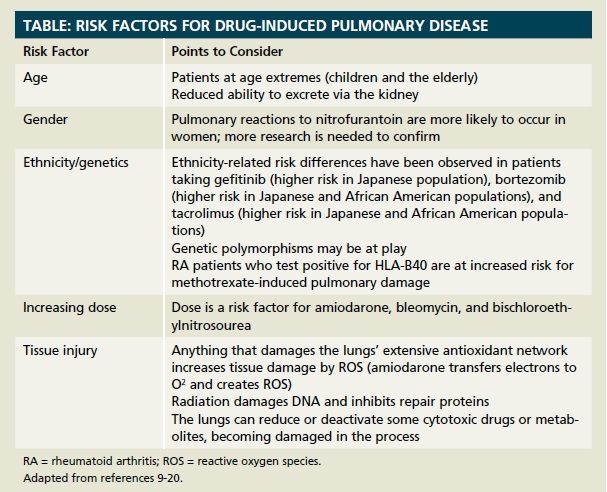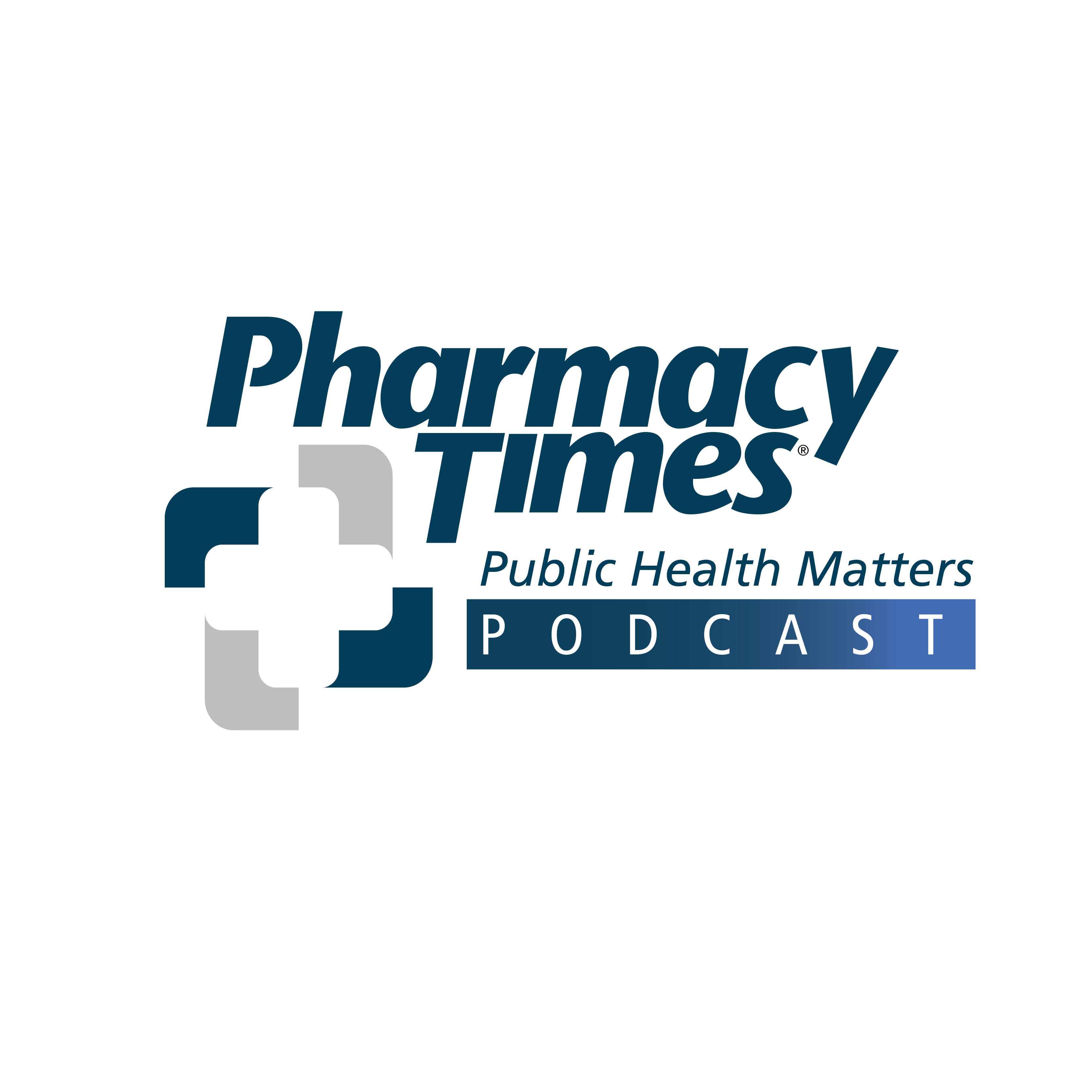Publication
Article
Pharmacy Times
Pulmonary Insult: Understanding Drug-Induced Lung Disease
Author(s):
The kidneys and liver get a lot of attention when it comes to adverse reactions, but the lungs are susceptible to damage as well.
The kidneys and liver get a lot of attention when it comes to adverse reactions, but the lungs are susceptible to damage as well.
When we think about adverse drug reactions (ADRs), we often think about the common (drowsiness, dizziness, rash) or the unusual and noteworthy (graying hair returning to its original color, or sensations of bugs crawling on skin). Often, lung damage doesn’t come to mind immediately. However, the lungs’ large surface area and ability to metabolize some drugs make them a target for toxicities.
More than 400 medications have been identified as causing respiratory diseases.1-4 Nonspecific clinical, radiologic, and histological findings make it difficult to diagnose lung-related ADRs, especially if the patient is taking multiple drugs. For this reason, lung-related ADRs are probably under-diagnosed.5 The exact incidence of drug-induced pulmonary toxicity is unknown, but it is estimated at approximately 3%.6,7
Tissue Damage
Drugs can injure airways, lung parenchyma, mediastinum, the neuromuscular system, pleura, or pulmonary vasculature, but most often they cause drug-induced interstitial lung disease (DILD). Oral and parenteral administration are most often implicated as causing lung damage, with nebulized and intrathecal routes implicated to a lesser extent.3,4
Onset may occur days, weeks, months, or even years after drug exposure. Most pulmonary ADRs are identified using laboratory findings (especially a complete blood count with differential to look for eosinophilia, a key finding), and nonspecific clinical symptoms such as cough, fever, dyspnea, wheezing, and hypoxemia. If dyspnea and/or pleuritic chest pain develop, the prudent clinician will order X-rays to rule out congestive heart failure, infectious disease, or malignancy.3,4
Drugs and biologics can cause different types of damage: bronchiolitis obliterans organizing pneumonia (BOOP), chronic interstitial pneumonia, desquamative interstitial pneumonia, diffuse alveolar damage, eosinophilic pneumonia, granulomatous lung disease, hypersensitivity pneumonitis, organizing pneumonia, and usual interstitial pneumonia.3 These ADRs may be acute, subacute, or chronic, with progressive dyspnea and fibrosis reducing exercise tolerance.8 Drug-induced pulmonary disease is definitive if drug withdrawal eliminates symptoms. Corticosteroids may be necessary in severe cases.
Who Is Affected?
For the most part, pulmonary ADRs are random, idiosyncratic events. They are most likely to develop in patients receiving chemotherapy, those who have autoimmune or inflammatory conditions, or those on multiple toxic agents (eg, cisplatin and bleomycin, or gemcitabine and bleomycin). The Table9-20 describes other risk factors.

Which Drugs?
Certain drugs have been identified as causing drug-induced pulmonary disease more often than others. A comprehensive list is available at Pneumotox online (www.pneumotox.com). In addition to more common agents, bromocriptine, carbamazepine, cabergolide, methysergide, penicillamine, phenytoin, sirolimus, and talc are also associated with lung disease more often than other drugs.
Bleomycin is the drug most frequently studied as a cause of drug-induced pulmonary toxicity, because up to 25% of patients develop this ADR.21 Among all drugs, amiodarone causes pulmonary abnormalities most often, affecting up to 6% of patients with mortality rates 10% to 20%.22 Its toxicity is dosedependent, increasing with increasing doses, and probably occurs secondary to phospholipid deposition in alveolar macrophages. Its presentation varies remarkably. Mortality in acute amiodarone pulmonary toxicity approaches 40% to 50%, despite drug withdrawal and corticosteroid therapy.23
The newer biologics—the monoclonal antibodies (MABs) that bind specifically to target cells—are the latest class implicated in pulmonary disease. In some patients, infectious complications follow, increasing morbidity and mortality. Researchers think that with these agents, like all others, lung injury results from cellular dysfunction (which induces apoptosis) or by impairing the cell and tissue repair sequence. Low serum albumin has been identified as a risk factor in cancer patients treated with MABs.24
Stop That Drug!
When drug-induced pulmonary disease is suspected, the first step is to withdraw the drug. Acute reactions usually resolve within a day or two and may be accompanied by peripheral eosinophilia that resolves as the reaction dissipates. Chronic reactions may take longer, and can be complicated by fibrosis that requires chronic supportive care.
Next, the health care team must manage symptoms. The goal is to stop the inflammatory response and prevent deposition of fibrotic tissue. Patients may require respiratory inhalers or supplemental oxygen. Corticosteroids may be particularly useful if the patient has BOOP, eosinophilic pneumonia, or hypersensitivity pneumonitis.4
Drug re-challenge is one way to confirm that the patient’s symptoms are druginduced, but this is a decision that must be made carefully, and is rarely used because of the risk. Pharmacists should remind patients who have DILD to stay up-to-date with pneumococcal and annual influenza virus vaccines.
Conclusion
Drug-induced pulmonary disease likely occurs more often than we know. All health care providers should be vigilant for pulmonary reactions after patients start new medications. In the case of pulmonary reactions, the vigilance cannot stop—these reactions can occur at any time and have life-threatening consequences.
Table 2: Agents Associated with Drug-Induced Pulmonary Disease
Antineoplastics
Antimicrobials
Anti-Inflammatory
Biologics
Cardiovascular Agents
Azathioprine
BCNU
Bleomycin
Bortezomib
Busulfan
Carmustine
Chlorambucil
Colony-stimulating factors
Cyclophosphamide
Cyclosporine
Cytarabine
Deferoxamine
Docetaxel
Doxorubicin
Erlotinib
Etoposide
Fludarabine
Flutamide
Gefitinib
Gemcitabine
Hydroxyurea
Imatinib
Interferons
Lomustine
Melphalan
Methotrexate
Methyl-CCNU
Mitomycin-C
Nitrosoureas
Paclitaxel
Procarbazine
Thalidomide
Vinca alkaloids
Zinostatin
Amphotericin B
Ethambutol
Isoniazid
Minocycline
Nitrofurantoin
Sulfasalazine
Aspirin
Etanercept
Gold
Infliximab
Methotrexate
Nonsteroidal anti-inflammatory drugs
Penicillamine
Adalimumab
Alemtuzumab
Bevacizumab
Cetuximab
Rituximab
Trastuzumab
Tumor necrosis factor (TNF)-alpha blockers
ACE inhibitors
Amiodarone
Anticoagulants
Beta-Blockers
Flecainide
Hydralazine
Hydrochlorothiazide
Procainamide
Statins
Tocainide
Bolded agents have highest incidence
Adapted from reference 2, 3, and 25.
Ms. Wick is a visiting professor at the University of Connecticut School of Pharmacy and a freelance writer from Virginia.
References
1. Camus P, Rosenow E. Latrogenic lung disease. Clin Chest Med. 2004;25:xiii-xix.
2. Flieder D, Travis W. Pathologic characteristics of drug-induced lung disease. Clin Chest Med. 2004;25:37-45.
3. Matsuno O. Drug-induced interstitial lung disease: mechanisms and best diagnostic approaches. Respir Res. 2012;13:39.
4. Schwaiblmair M, Behr W, Haeckel T, Märkl B, Foerg W, Berghaus T. Drug induced interstitial lung disease. Open Respir Med J. 2012;6:63-74.
5. Nemery B, Bast A, Behr J, et al. Interstitial lung disease induced by exogenous agents: factors governing susceptibility. Eur Respir J. 2001;18:30S-42S.
6. Coultas D, Zumwalt R, Black W, et al. The epidemiology of interstitial lung diseases. Am J Respir Crit Care Med. 1994;150:967-972.
7. Thomeer M, Costabel U, Rizzato G, et al. Comparison of registries of interstitial lung diseases in three European countries. Eur Respir J. 2001;18:114s-118s.
8. Ganguli A, Pirmohamed M. Management of drug-induced interstitial lung disease. Prescriber. 2006;5:41-46.
9. Simpson A, Paul J, Graham J, Kaye S. Fatal bleomycin pulmonary toxicity in the west of Scotland 1991-95: a review of patients with germ cell tumours. Br J Cancer. 1998;78:1061-1066.
10. Mendez J, Nardous H, Hartman T, et al. Chronic nitrofuranto-ininduced lung disease. Mayo Clin Proc. 2005;80:1298-1302.
11. Kudoh S, Kato H, Nishiwaki Y, et al. Japan Thoracic Radiology Group Interstitial lung disease in Japanese patients with lung cancer: a cohort and nested case-control study. Am J Respir Crit Care Med. 2008;177:1348-1357.
12. Miyakoshi S, Kami M, Yuji K, et al. Severe pulmonary complications in Japanese patients after bortezomib treatment for refractory multiple myeloma. Blood. 2006;107:3492-3494.
13. Ingelman-Sundberg M, Sim S, Gomez A, et al. Influence of cytochrome P450 polymorphisms on drug therapies: pharmacogenetic, pharmacoepigenetic and clinical aspects. Pharmacol Ther. 2007;116:496-526.
14. Miwa Y, Isozaki T, Wakabayashi K, et al. Tacrolimus-induced lung injury in a rheumatoid arthritis patient with interstitial pneumonitis. Mod Rheumatol. 2008;18:208-211.
15. Vorperian V, Havighurst T, Millrer S, January C. Adverse effects of low dose amiodarone: a meta-analysis. J Am Coll Cardiol. 1997;30:791-798.
16. Yamada Y, Shiga T, Matsuda N, et al. Incidence and predictors of pulmonary toxicity in Japanese patients receiving low-dose amiodarone. Circ J. 2007;71:1610-1616.
17. Aronin P, Mahaley M, Rudnick S, et al. Prediction of BCNU pulmonary toxicity in patients with malignant gliomas: an assessment of risk factors. N Engl J Med. 1980;303:183-188.
18. Stemmer S, Cagnoni P, Shpall E, et al. High-dose paclitaxel, cyclophosphamide, and cisplastin with autologous hematopoietic progenitor-cell support: a phase I trial. J Clin Oncol. 1996;14:1463-1472.
19. Parish J, Muhm J, Leslie K. Upper lobe pulmonary fibrosis associated with high-dose chemotherapy containing BCNU for bone marrow transplantation. Mayo Clin Proc. 2003;78:630-634.
20. Oya N, Sasai K, Tachiiri S, et al. Influence of radiation dose rate and lung dose on interstitial pneumonitis after fractionated total body irradiation: acute parotitis may predict interstitial pneumonitis. Int J Hematol. 2006;83:86-91.
21. Pneumotox online: the drug-induced lung diseases. www.pneumotox.com. Accessed September 9, 2012.
22. Jules-Elysee K, White DA. Bleomycin induced pulmonary toxicity. Clin Chest Med. 1990;11:1-20.
23. Schwaiblmair M, Berghaus T, Haeckel T, et al. Amiodarone-induced pulmonary toxicity: an underrecognized and severe adverse effect? Clin Res Cardiol. 2010;99:693-700.
24. Camus P, Fanton A, Bonniaud P, Camus C, Foucher P. Interstitial lung disease induced by drugs and radiation. Respiration. 2004;71:301-326.
25. Kang HJ, Park JS, Kim DW, et al. Adverse pulmonary reactions associated with the use of monoclonal antibodies in cancer patients. Respir Med. 2012;106:443-450.







